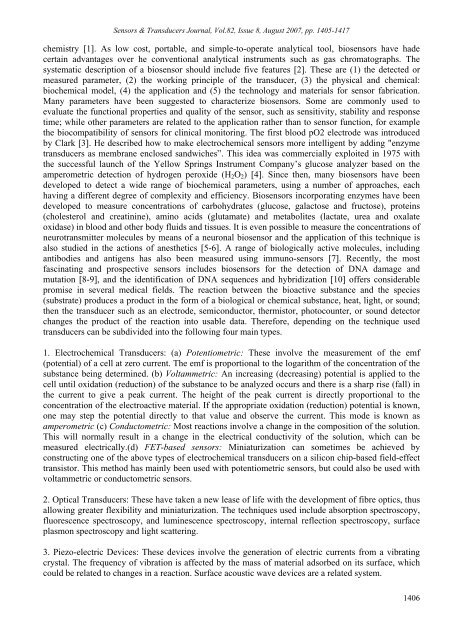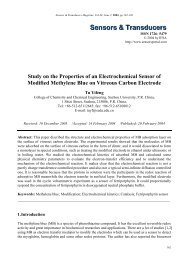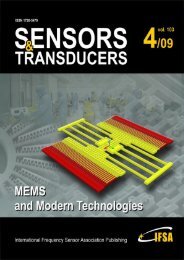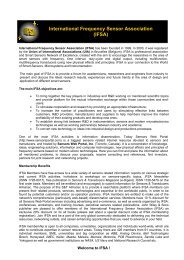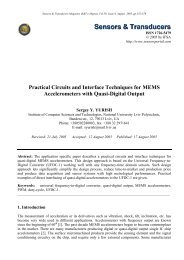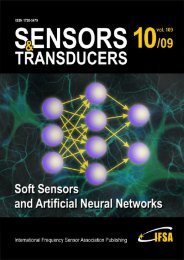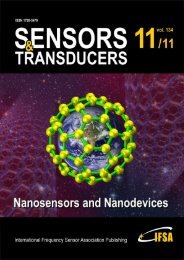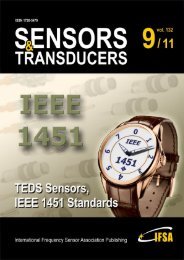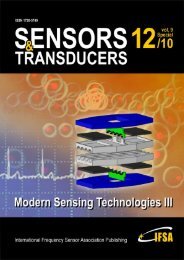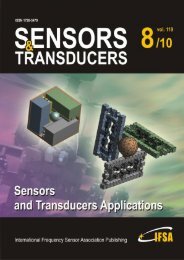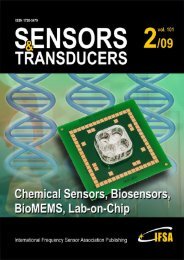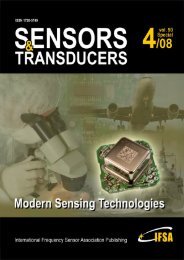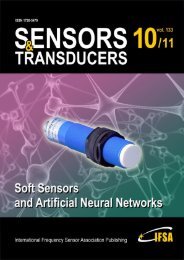Bio-Techniques in Electrochemical Transducers: an Overview
Bio-Techniques in Electrochemical Transducers: an Overview
Bio-Techniques in Electrochemical Transducers: an Overview
You also want an ePaper? Increase the reach of your titles
YUMPU automatically turns print PDFs into web optimized ePapers that Google loves.
Sensors & <strong>Tr<strong>an</strong>sducers</strong> Journal, Vol.82, Issue 8, August 2007, pp. 1405-1417<br />
chemistry [1]. As low cost, portable, <strong>an</strong>d simple-to-operate <strong>an</strong>alytical tool, biosensors have hade<br />
certa<strong>in</strong> adv<strong>an</strong>tages over he conventional <strong>an</strong>alytical <strong>in</strong>struments such as gas chromatographs. The<br />
systematic description of a biosensor should <strong>in</strong>clude five features [2]. These are (1) the detected or<br />
measured parameter, (2) the work<strong>in</strong>g pr<strong>in</strong>ciple of the tr<strong>an</strong>sducer, (3) the physical <strong>an</strong>d chemical:<br />
biochemical model, (4) the application <strong>an</strong>d (5) the technology <strong>an</strong>d materials for sensor fabrication.<br />
M<strong>an</strong>y parameters have been suggested to characterize biosensors. Some are commonly used to<br />
evaluate the functional properties <strong>an</strong>d quality of the sensor, such as sensitivity, stability <strong>an</strong>d response<br />
time; while other parameters are related to the application rather th<strong>an</strong> to sensor function, for example<br />
the biocompatibility of sensors for cl<strong>in</strong>ical monitor<strong>in</strong>g. The first blood pO2 electrode was <strong>in</strong>troduced<br />
by Clark [3]. He described how to make electrochemical sensors more <strong>in</strong>telligent by add<strong>in</strong>g "enzyme<br />
tr<strong>an</strong>sducers as membr<strong>an</strong>e enclosed s<strong>an</strong>dwiches”. This idea was commercially exploited <strong>in</strong> 1975 with<br />
the successful launch of the Yellow Spr<strong>in</strong>gs Instrument Comp<strong>an</strong>y’s glucose <strong>an</strong>alyzer based on the<br />
amperometric detection of hydrogen peroxide (H2O2) [4]. S<strong>in</strong>ce then, m<strong>an</strong>y biosensors have been<br />
developed to detect a wide r<strong>an</strong>ge of biochemical parameters, us<strong>in</strong>g a number of approaches, each<br />
hav<strong>in</strong>g a different degree of complexity <strong>an</strong>d efficiency. <strong>Bio</strong>sensors <strong>in</strong>corporat<strong>in</strong>g enzymes have been<br />
developed to measure concentrations of carbohydrates (glucose, galactose <strong>an</strong>d fructose), prote<strong>in</strong>s<br />
(cholesterol <strong>an</strong>d creat<strong>in</strong><strong>in</strong>e), am<strong>in</strong>o acids (glutamate) <strong>an</strong>d metabolites (lactate, urea <strong>an</strong>d oxalate<br />
oxidase) <strong>in</strong> blood <strong>an</strong>d other body fluids <strong>an</strong>d tissues. It is even possible to measure the concentrations of<br />
neurotr<strong>an</strong>smitter molecules by me<strong>an</strong>s of a neuronal biosensor <strong>an</strong>d the application of this technique is<br />
also studied <strong>in</strong> the actions of <strong>an</strong>esthetics [5-6]. A r<strong>an</strong>ge of biologically active molecules, <strong>in</strong>clud<strong>in</strong>g<br />
<strong>an</strong>tibodies <strong>an</strong>d <strong>an</strong>tigens has also been measured us<strong>in</strong>g immuno-sensors [7]. Recently, the most<br />
fasc<strong>in</strong>at<strong>in</strong>g <strong>an</strong>d prospective sensors <strong>in</strong>cludes biosensors for the detection of DNA damage <strong>an</strong>d<br />
mutation [8-9], <strong>an</strong>d the identification of DNA sequences <strong>an</strong>d hybridization [10] offers considerable<br />
promise <strong>in</strong> several medical fields. The reaction between the bioactive subst<strong>an</strong>ce <strong>an</strong>d the species<br />
(substrate) produces a product <strong>in</strong> the form of a biological or chemical subst<strong>an</strong>ce, heat, light, or sound;<br />
then the tr<strong>an</strong>sducer such as <strong>an</strong> electrode, semiconductor, thermistor, photocounter, or sound detector<br />
ch<strong>an</strong>ges the product of the reaction <strong>in</strong>to usable data. Therefore, depend<strong>in</strong>g on the technique used<br />
tr<strong>an</strong>sducers c<strong>an</strong> be subdivided <strong>in</strong>to the follow<strong>in</strong>g four ma<strong>in</strong> types.<br />
1. <strong>Electrochemical</strong> <strong>Tr<strong>an</strong>sducers</strong>: (a) Potentiometric: These <strong>in</strong>volve the measurement of the emf<br />
(potential) of a cell at zero current. The emf is proportional to the logarithm of the concentration of the<br />
subst<strong>an</strong>ce be<strong>in</strong>g determ<strong>in</strong>ed. (b) Voltammetric: An <strong>in</strong>creas<strong>in</strong>g (decreas<strong>in</strong>g) potential is applied to the<br />
cell until oxidation (reduction) of the subst<strong>an</strong>ce to be <strong>an</strong>alyzed occurs <strong>an</strong>d there is a sharp rise (fall) <strong>in</strong><br />
the current to give a peak current. The height of the peak current is directly proportional to the<br />
concentration of the electroactive material. If the appropriate oxidation (reduction) potential is known,<br />
one may step the potential directly to that value <strong>an</strong>d observe the current. This mode is known as<br />
amperometric (c) Conductometric: Most reactions <strong>in</strong>volve a ch<strong>an</strong>ge <strong>in</strong> the composition of the solution.<br />
This will normally result <strong>in</strong> a ch<strong>an</strong>ge <strong>in</strong> the electrical conductivity of the solution, which c<strong>an</strong> be<br />
measured electrically.(d) FET-based sensors: M<strong>in</strong>iaturization c<strong>an</strong> sometimes be achieved by<br />
construct<strong>in</strong>g one of the above types of electrochemical tr<strong>an</strong>sducers on a silicon chip-based field-effect<br />
tr<strong>an</strong>sistor. This method has ma<strong>in</strong>ly been used with potentiometric sensors, but could also be used with<br />
voltammetric or conductometric sensors.<br />
2. Optical <strong>Tr<strong>an</strong>sducers</strong>: These have taken a new lease of life with the development of fibre optics, thus<br />
allow<strong>in</strong>g greater flexibility <strong>an</strong>d m<strong>in</strong>iaturization. The techniques used <strong>in</strong>clude absorption spectroscopy,<br />
fluorescence spectroscopy, <strong>an</strong>d lum<strong>in</strong>escence spectroscopy, <strong>in</strong>ternal reflection spectroscopy, surface<br />
plasmon spectroscopy <strong>an</strong>d light scatter<strong>in</strong>g.<br />
3. Piezo-electric Devices: These devices <strong>in</strong>volve the generation of electric currents from a vibrat<strong>in</strong>g<br />
crystal. The frequency of vibration is affected by the mass of material adsorbed on its surface, which<br />
could be related to ch<strong>an</strong>ges <strong>in</strong> a reaction. Surface acoustic wave devices are a related system.<br />
1406


